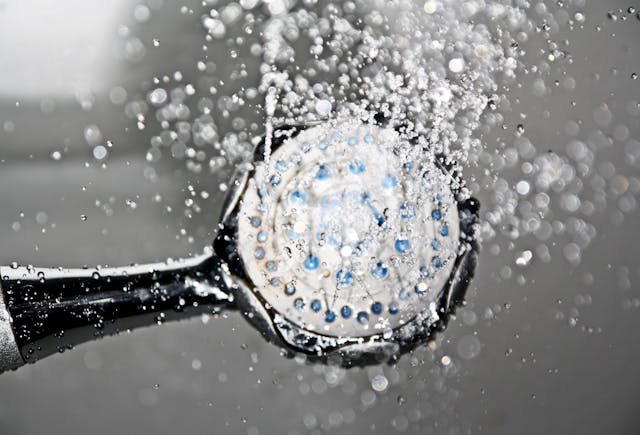Tired of a clogged shower head that barely sprays? Don’t worry, you don’t always need harsh chemicals like vinegar to get it clean and flowing again!
This guide is here to help you restore your shower head’s full power with easy, vinegar-free methods that work like a charm. Whether you’re out of vinegar, dealing with a sensitive material, or simply prefer alternative solutions, we’ve got you covered.
Not only are these methods eco-friendly, but they’re also gentle on delicate finishes, safe for your health, and use items you likely already have at home. Say goodbye to frustrating showers and hello to “How To Clean Shower Head Without Vinegar step by step guide” Let’s dive in.

Why Does the clean shower head need Cleaning?
Your shower head plays a vital role in providing a refreshing start to your day, but over time, it can become clogged or less efficient. Regular cleaning is essential to keep it functioning optimally and ensure a pleasant shower experience. Here’s why:
1. Mineral Buildup
As water flows through the shower head, minerals like calcium, magnesium, and lime from hard water can accumulate over time. This mineral buildup clogs the nozzles, reducing water pressure and leading to uneven sprays. Regular cleaning removes these deposits and restores your shower’s performance.
2. Bacteria and Mold Growth
A damp environment combined with leftover water in the shower head creates the perfect breeding ground for bacteria, mold, and mildew. Cleaning the shower head prevents the buildup of harmful microorganisms, promoting better hygiene and reducing potential health risks.
3. Improved Efficiency
A clogged shower head can strain your plumbing system as it struggles to maintain water flow. By keeping it clean, you ensure efficient water usage and avoid unnecessary stress on your faucet or water heater.
4. Longer Lifespan
Neglecting to clean your shower head can lead to corrosion or permanent blockages, shortening its lifespan. Regular maintenance helps preserve its materials and finishes, saving you from costly replacements.
5. Enhanced Shower Experience
A clean shower head ensures a consistent and invigorating spray, turning your daily routine into a spa-like experience. Plus, it eliminates unsightly grime or stains, keeping your bathroom looking fresh and inviting.
Cleaning your shower head is a simple yet crucial task to maintain hygiene, functionality, and the overall quality of your showers. By addressing mineral deposits, bacteria, and mold, you’ll enjoy a more efficient and enjoyable shower every time.
Read: How To Clean A Coffee Maker Without Vinegar?
Why Avoid Vinegar for Shower Head Cleaning?
Cleaning your shower head is essential for maintaining water flow and hygiene, but using vinegar isn’t always the best option. Here’s why you might want to reconsider reaching for that bottle of vinegar.
Potential Damage to Materials
Vinegar, while effective, is acidic and can damage certain shower head materials over time. Finishes like chrome, brass, or nickel are particularly vulnerable, as prolonged exposure to vinegar can cause discoloration, tarnishing, or corrosion. If you’ve invested in a high-quality showerhead, keeping its shine intact is just as important as keeping it clean.
Environmental Concerns
While vinegar is often touted as an eco-friendly cleaning solution, overusing it can still contribute to environmental issues. Large-scale or frequent disposal of acidic solutions can harm water systems and soil, especially when combined with other household cleaners. Choosing less acidic, more natural alternatives can reduce your environmental footprint.
Alternative Solutions to Consider
Thankfully, there are several vinegar-free methods to effectively clean a shower head without risking damage or causing environmental harm. Using baking soda, mild dish soap, and other household staples, you can create a safe and effective cleaning solution. These methods not only help you clean the shower and restore water flow but also keep your showerhead in pristine condition for years to come.
In the sections ahead, we’ll walk you through step-by-step instructions for these alternative methods to clean a shower head. Get ready to say goodbye to buildup and hello to a better shower experience—no vinegar needed!

Vinegar-Free Cleaning Methods: How To Clean Shower Head Without Vinegar
If you’re looking for effective ways to clean the shower head without using vinegar, these simple methods will leave it sparkling clean while being gentle on the material. Let’s explore two easy and effective options for a deep clean to remove mineral buildup and restore water flow.
1. Baking Soda and Water
Baking soda is a fantastic, gentle cleanser that works wonders on mineral deposits without damaging delicate surfaces.
Method:
- In a bowl, mix 3 tablespoons of baking soda with enough water to create a thick paste.
- Using your hands or a small spatula, apply the paste evenly over the shower head, paying extra attention to areas with heavy mineral buildup.
- Let the paste sit for 15–20 minutes to loosen the deposits.
- Take an old toothbrush and gently scrub the surface and nozzle holes to dislodge stubborn debris.
- Rinse thoroughly with warm water to remove all traces of baking soda. You can even place the shower head in a plastic bag filled with water for easier rinsing.
Tips:
After rinsing, reattach the shower head to the faucet, and turn on the shower to flush out any loosened deposits from inside.
2. Lemon Juice and Salt
For a natural and fragrant cleaner, lemon juice combined with salt offers a mildly abrasive and effective solution for tackling grime and mineral deposits.
Method:
- In a small container, mix fresh lemon juice with a tablespoon of salt to form a gritty paste.
- Use a cloth or your fingers to apply the paste onto the shower head, focusing on areas with visible mineral deposits.
- Allow it to sit for about 10–15 minutes to break down the buildup.
- With a toothbrush, gently scrub the nozzle openings and outer surface.
- Rinse the shower head thoroughly under running water to remove all residue.
Tips:
Lemon juice’s acidity can be harsh on certain metals like brass or nickel, so test a small area first if your shower head has these finishes. After rinsing, run warm water through the head by turning on the shower to ensure no salt or lemon residue is left inside.
With these vinegar-free methods, you can easily deep clean your shower head, eliminate mineral deposits, and enjoy a revitalized shower experience. Just grab a rubber band, a plastic bag, and a little elbow grease to get started—you’ll love the results!
3. Commercial Shower Head Cleaners
Commercial cleaners designed specifically for shower head cleaning can be a convenient option for tackling stubborn mineral deposits and restoring water flow.
Method:
- Choose a reputable shower head cleaning solution designed to dissolve buildup effectively.
- Apply the cleaner directly to the shower head, following the product’s instructions. Many cleaners work by spraying or soaking the shower head.
- Let the cleaner sit for the recommended time to break down the deposits, then rinse thoroughly with water.
Tips:
Opt for eco-friendly and non-toxic cleaners to ensure they’re safe for your home, your health, and the environment. Always test on a small area first if your shower head has a delicate finish.
Caution:
Carefully read and follow the product instructions, especially regarding contact time and rinsing, to avoid damage to your shower head.
4. Plastic Bag and White Vinegar (For Stubborn Clogs)
When all else fails, soaking the shower head in vinegar can be an effective solution for severe clogs. This method is particularly useful for cleaning without removing the shower head from the wall.
Method:
- Fill a plastic bag with white vinegar, enough to fully submerge the shower head.
- Carefully place the bag over the shower head, ensuring it covers the nozzles.
- Use a rubber band to securely fasten the bag in place.
- Allow the shower head to soak for 2–3 hours, or overnight for severe buildup.
- After soaking, remove the bag and turn on the water to flush out loosened debris and restore water pressure.
Caution:
This method should be used as a last resort and only on shower heads compatible with vinegar, as it can damage certain materials like brass, nickel, or gold finishes. Always rinse thoroughly to remove all traces of vinegar, and consider an alternative solution if your shower head is delicate.
With these methods—ranging from commercial cleaners to the plastic bag over the shower head technique—you’ll find the perfect approach to clean your showerhead and get rid of even the most stubborn buildup.
Prevention Tips for Keeping Your Shower Head Clean
Regular cleaning and simple adjustments can go a long way in maintaining a clean and efficient shower head. Here are some easy-to-follow prevention tips to reduce buildup and extend the life of your shower head.
1. Regular Cleaning
Performing regular, light cleaning is the easiest way to prevent mineral buildup and maintain water flow.
- Wipe the surface of the shower head with a damp cloth every week to remove any visible grime.
- Once a month, use a gentle cleaning solution like baking soda paste or mild dish soap to give your shower head a quick refresh.
- Don’t forget to pay attention to the nozzles—gently scrub them with a toothbrush or use your fingers to dislodge any debris.
Regular upkeep ensures that buildup doesn’t have a chance to accumulate, keeping your shower head in top condition.
2. Install a Water Filter
Hard water is the main culprit behind mineral deposits that clog your shower head. Installing a water filter can significantly reduce the problem.
- Water filters are designed to trap impurities, including minerals like calcium and magnesium, before they reach your shower head.
- This not only prevents mineral buildup but also improves the overall quality of your water, making it gentler on your skin and hair.
- Filters are easy to attach to your shower faucet and require minimal maintenance.
Investing in a water filter is a smart and cost-effective way to minimize cleaning efforts while prolonging the life of your shower head.
3. Adjusting Water Pressure
High water pressure can exacerbate mineral buildup by forcing more water (and its mineral content) through the nozzles. Adjusting the pressure can help minimize this effect.
- Check your faucet or water pressure regulator to ensure it’s set at an optimal level. A pressure of 40–60 PSI is usually sufficient for a comfortable shower.
- Lower pressure reduces the amount of mineral-laden water flowing through the shower head, slowing down the accumulation of deposits.
- If you notice persistently high pressure, consider installing a pressure-reducing valve to protect your shower head and plumbing.
Conclusion: Keeping Your Shower Head Clean and Safe
Knowing how to clean a shower head without vinegar means you can keep it sparkling and functional without risking damage or relying on harsh chemicals. Methods like baking soda, lemon juice, and even commercial cleaning solutions prove that effective cleaning can be gentle on materials and eco-friendly too.
Each of these techniques offers unique advantages, so pick the one that matches your needs and works best with your shower head’s material. Whether you’re deep-cleaning or simply refreshing, there’s a solution that ensures your shower stays enjoyable and efficient.
Don’t forget, regular maintenance is the secret to avoiding stubborn clogs and keeping your shower head in top shape. By staying proactive and learning how to clean shower head without vinegar, you’ll enjoy stronger water pressure, better hygiene, and the satisfaction of knowing your shower is always ready to perform its best. So go ahead—take that shower to the next level, minus the vinegar!

Anamika is a passionate writer for Eco365Store.com, specializing in topics that inspire a cleaner, greener world. With expertise in home cleaning, recycling, and eco-friendly solutions, she crafts engaging and informative articles that help readers adopt sustainable practices in their daily lives.
